INTERNATIONAL
STANDARD
ISO/IEC
11179-1
Third edition
2015-12-15
Part 1:
Information technology — Metadata
registries (MDR) —
Framework
Technologies de l’information — Registres de métadonnées (RM) —
Partie 1: Cadre de référence
Reference number
ISO/IEC 11179-1:2015(E)
© ISO/IEC 2015
�
ISO/IEC 11179-1:2015(E)
COPYRIGHT PROTECTED DOCUMENT
© ISO/IEC 2015, Published in Switzerland
All rights reserved. Unless otherwise specified, no part of this publication may be reproduced or utilized otherwise in any form
or by any means, electronic or mechanical, including photocopying, or posting on the internet or an intranet, without prior
written permission. Permission can be requested from either ISO at the address below or ISO’s member body in the country of
the requester.
ISO copyright office
Ch. de Blandonnet 8 • CP 401
CH-1214 Vernier, Geneva, Switzerland
Tel. +41 22 749 01 11
Fax +41 22 749 09 47
copyright@iso.org
www.iso.org
ii
© ISO/IEC 2015 – All rights reserved
�
ISO/IEC 11179-1:2015(E)
4
5
1
2
3
Contents
Page
Foreword ........................................................................................................................................................................................................................................iv
Introduction ..................................................................................................................................................................................................................................v
Scope .................................................................................................................................................................................................................................1
Normative references ......................................................................................................................................................................................1
Terms, definitions and abbreviations ............................................................................................................................................1
Definitions of modelling constructs ......................................................................................................................................1
3.1
General terms used in this part of ISO/IEC 11179...................................................................................................2
3.2
3.3
Alphabetical list of terms used in the metamodel ....................................................................................................4
Specific terms used in ISO/IEC 11179-6 ..........................................................................................................................8
3.4
3.5
Specific terms used in this part of ISO/IEC 11179 ...................................................................................................9
Theory of terminology ....................................................................................................................................................................................9
Metadata .......................................................................................................................................................................................................................9
5.1
General ...........................................................................................................................................................................................................9
Concepts ....................................................................................................................................................................................................10
5.2
5.2.1
General...................................................................................................................................................................................10
5.2.2 Management .....................................................................................................................................................................10
5.3
Fundamental model of data elements .............................................................................................................................10
Data elements in data management and interchange ........................................................................................12
5.4
Fundamental model of value domains ............................................................................................................................12
5.5
5.6
Fundamental model of concept systems .......................................................................................................................15
Metadata registries .........................................................................................................................................................................................16
General ........................................................................................................................................................................................................16
6.1
Overview model for an ISO/IEC 11179 MDR.............................................................................................................17
6.2
6.3
Fundamentals of registration ..................................................................................................................................................18
Overview of ISO/IEC 11179, Parts 1–6 ........................................................................................................................................19
Part 1 ............................................................................................................................................................................................................19
7.1
Part 2 ............................................................................................................................................................................................................19
7.2
7.3
Part 3 ............................................................................................................................................................................................................19
Part 4 ............................................................................................................................................................................................................20
7.4
7.5
Part 5 ............................................................................................................................................................................................................20
7.6
Part 6 ............................................................................................................................................................................................................20
Basic principles for applying ISO/IEC 11179, Parts 1–6 .................................................................................21
7.7
Conformance ..........................................................................................................................................................................................................21
Bibliography .............................................................................................................................................................................................................................22
6
7
8
© ISO/IEC 2015 – All rights reserved
iii
�
ISO/IEC 11179-1:2015(E)
Foreword
ISO (the International Organization for Standardization) and IEC (the International Electrotechnical
Commission) form the specialized system for worldwide standardization. National bodies that are
members of ISO or IEC participate in the development of International Standards through technical
committees established by the respective organization to deal with particular fields of technical
activity. ISO and IEC technical committees collaborate in fields of mutual interest. Other international
organizations, governmental and non-governmental, in liaison with ISO and IEC, also take part in the
work. In the field of information technology, ISO and IEC have established a joint technical committee,
ISO/IEC JTC 1.
The procedures used to develop this document and those intended for its further maintenance are
described in the ISO/IEC Directives, Part 1. In particular the different approval criteria needed for
the different types of document should be noted. This document was drafted in accordance with the
editorial rules of the ISO/IEC Directives, Part 2 (see www.iso.org/directives).
Attention is drawn to the possibility that some of the elements of this document may be the subject
of patent rights. ISO and IEC shall not be held responsible for identifying any or all such patent
rights. Details of any patent rights identified during the development of the document will be in the
Introduction and/or on the ISO list of patent declarations received (see www.iso.org/patents).
Any trade name used in this document is information given for the convenience of users and does not
constitute an endorsement.
For an explanation on the meaning of ISO specific terms and expressions related to conformity
assessment, as well as information about ISO’s adherence to the WTO principles in the Technical
Barriers to Trade (TBT) see the following URL: Foreword - Supplementary information
The committee responsible for this document is ISO/IEC JTC1, Information technology, SC32, Data
management and interchange.
This third edition of ISO 11179-1 cancels and replaces ISO 11179-1:2004, which has been technically
revised.
ISO/IEC 11179 consists of the following parts, under the general title Information technology —
Metadata registries (MDR):
— Part 1: Framework
— Part 2: Classification
— Part 3: Registry metamodel and basic attributes
— Part 4: Formulation of data definitions
— Part 5: Naming principles
— Part 6: Registration
iv
© ISO/IEC 2015 – All rights reserved
�
ISO/IEC 11179-1:2015(E)
Introduction
ISO/IEC 11179 addresses the semantics of data, the representation of data and the registration of
the descriptions of that data. It is through these descriptions that an accurate understanding of the
semantics and a useful depiction of the data are found.
The purposes of ISO/IEC 11179 is to promote the following:
— standard description of data;
— common understanding of data across organizational elements and between organizations;
— re-use and standardization of data over time, space, and applications;
— harmonization and standardization of data within an organization and across organizations;
— management of the components of descriptions of data;
— re-use of the components of descriptions of data.
Each part of ISO/IEC 11179 is devoted to addressing a different aspect of these needs:
— Part 1: Framework – Contains an overview of the Standard and describes the basic concepts;
— Part 2: Classification – Describes how to manage a classification scheme in a metadata registry;
— Part 3: Registry metamodel and basic attributes – Provides the conceptual model, including the basic
attributes and relationships, for a metadata registry;
— Part 4: Formulation of data definitions – Gives rules and guidelines for forming quality definitions for
data elements and their components;
— Part 5: Naming principles – Describes how to form conventions for naming data elements and
their components;
— Part 6: Registration – Specifies the roles and requirements for the registration process in an
ISO/IEC 11179 metadata registry.
Generally, descriptive data are known as metadata. Metadata can describe books, phone calls, data, etc.
ISO/IEC 11179 focuses upon metadata that describes data.
NOTE
In ISO/IEC 11179 (all parts), metadata refers to descriptions of data. It does not contain a general
treatment of metadata.
A metadata registry (MDR) is a database of metadata. Registration is one possible function of that
database. Registration accomplishes three main goals: identification, provenance, and monitoring
quality. Identification is accomplished by assigning a unique identifier (within the registry) to each
object registered there. Provenance addresses the source of the metadata and the object described.
Monitoring quality ensures that the metadata does the job it is designed to do.
An MDR may contain the semantics of data. An understanding of data is fundamental to their design,
harmonization, standardization, use, re-use and interchange. The underlying model for an MDR is
designed to capture all the basic components of the semantics of data, independent of any application or
subject matter area.
MDRs, typically, are organized so that those designing applications can ascertain whether a suitable
object described in the MDR already exists. Where it is established that a new object is essential, its
derivation from an existing description with appropriate modifications is encouraged, thus avoiding
unnecessary variations in the way similar objects are described. Registration will also allow two or
more administered items describing identical objects to be identified, and more importantly, it will
help to identify situations where similar or identical names are in use for administered items that are
significantly different in one or more respects.
v
© ISO/IEC 2015 – All rights reserved
�
ISO/IEC 11179-1:2015(E)
In ISO/IEC 11179 the basic container for data is called a data element. It may exist purely as an
abstraction or exist in some application system. In either case, the description of a data element
is the same in ISO/IEC 11179. Data element descriptions have both semantic and representational
components. The semantics are further divided into contextual and symbolic types.
The contextual semantics are described by the data element concept (DEC). The DEC describes the
kind of objects for which data are collected and the particular characteristic of those objects being
measured. The symbolic semantics are described by the conceptual domain (CD). A CD is a set of
concepts, not necessarily finite, where the concepts represent the meaning of the permissible values in
a value domain. A value domain contains the allowed values for a data element.
The names, definitions, datatype and related attributes that are associated with the description of an
object in an MDR give that object meaning. The depth of this meaning is limited, because names and
definitions convey limited information about the object. The relationships object descriptions have
with semantically related object descriptions in a registry provide additional information, but this
additional information is dependent on how many semantically related object descriptions there are.
This third edition of ISO/IEC 11179-1 introduces concepts and concept systems in the description of the
semantics of data. Object classes, properties, DECs, value meanings and CDs are concepts. Therefore,
they have definitions and may be designated by names or codes. They may also be organized through
the use of relations among them into concept systems. A classification scheme is a concept system that
is used for classifying some objects and classification of an object adds meaning to that object.
Features needed for formal reasoning are also new to this third edition of ISO/IEC 11179-1. Applying
the rules of some form of formal logic (1st order logic, predicate calculus, description logic, etc.) may
add additional abilities to query and reason with concept systems. Ontologies are concept systems that
allow the application of formal logic and this edition provides for their use.
The representational component is about the permitted values a data element may use. Each such
permissible value is a designation of one of the concepts in the CD. The set of these permissible values is
called a value domain (VD). A VD specifies all the values that are allowed either through an enumeration,
a rule, or a combination of these. The computational model the values follow is given by their datatype.
The semantic and representational components are described through attributes contained in the
conceptual model of a metadata registry as specified in ISO/IEC 11179-3. A metadata registry that
conforms to ISO/IEC 11179 can describe a wide variety of data. In fact, the attributes described in
ISO/IEC 11179-3 are data elements, and they can be registered in an ISO/IEC 11179 metadata registry.
Moreover, any set of descriptors or metadata attributes may be interpreted as data elements and
registered in the metadata registry.
There are two main consequences to this:
— the metadata registry can describe itself;
— metadata layers or levels are not defined in ISO/IEC 11179.
As a result, ISO/IEC 11179 is a general description framework for data of any kind, in any organization
and for any purpose. ISO/IEC 11179 does not address other data management needs, such as data
models, application specifications, programming code, program plans, business plans and business
policies. These need to be addressed elsewhere.
The increased use of data processing and electronic data interchange heavily relies on accurate, reliable,
controllable and verifiable data recorded in databases. One of the prerequisites for a correct and proper
use and interpretation of data is that both users and owners of data have a common understanding
of the meaning and descriptive characteristics (e.g., representation) of that data, guaranteed by the
definition of several basic attributes.
The basic attributes specified are applicable for the definition and specification of the contents of data
dictionaries and interchanging or referencing among various collections of administered items. The
vi
© ISO/IEC 2015 – All rights reserved
�
ISO/IEC 11179-1:2015(E)
“basic” in basic attributes means that the attributes are commonly needed in specifying administered
items completely enough to ensure that they will be applicable for a variety of functions, such as:
— design of information processing systems,
— retrieval of data from databases,
— design of messages for data interchange,
— maintenance of metadata registries,
— data management,
— dictionary design,
— dictionary control,
— use of information processing systems.
Basic also implies that they are independent of any:
— application environment,
—
function of an object described by an administered item,
—
level of abstraction,
— grouping of administered items,
— method for designing information processing systems or data interchange messages,
— MDR system.
Basic does not imply that all attributes specified in ISO/IEC 11179-3 are required in all cases. Distinction
is made between those attributes that are mandatory, conditional, or optional.
© ISO/IEC 2015 – All rights reserved
vii
�
�
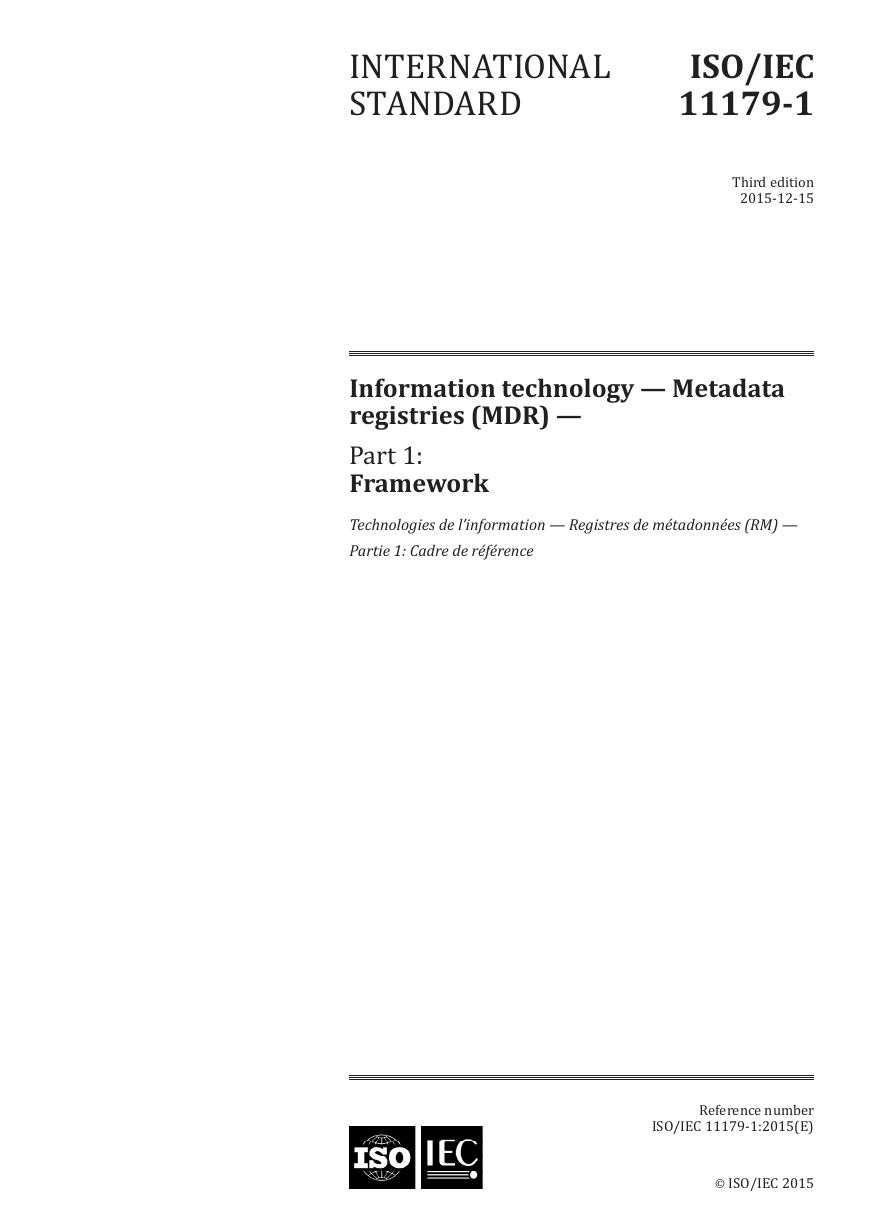
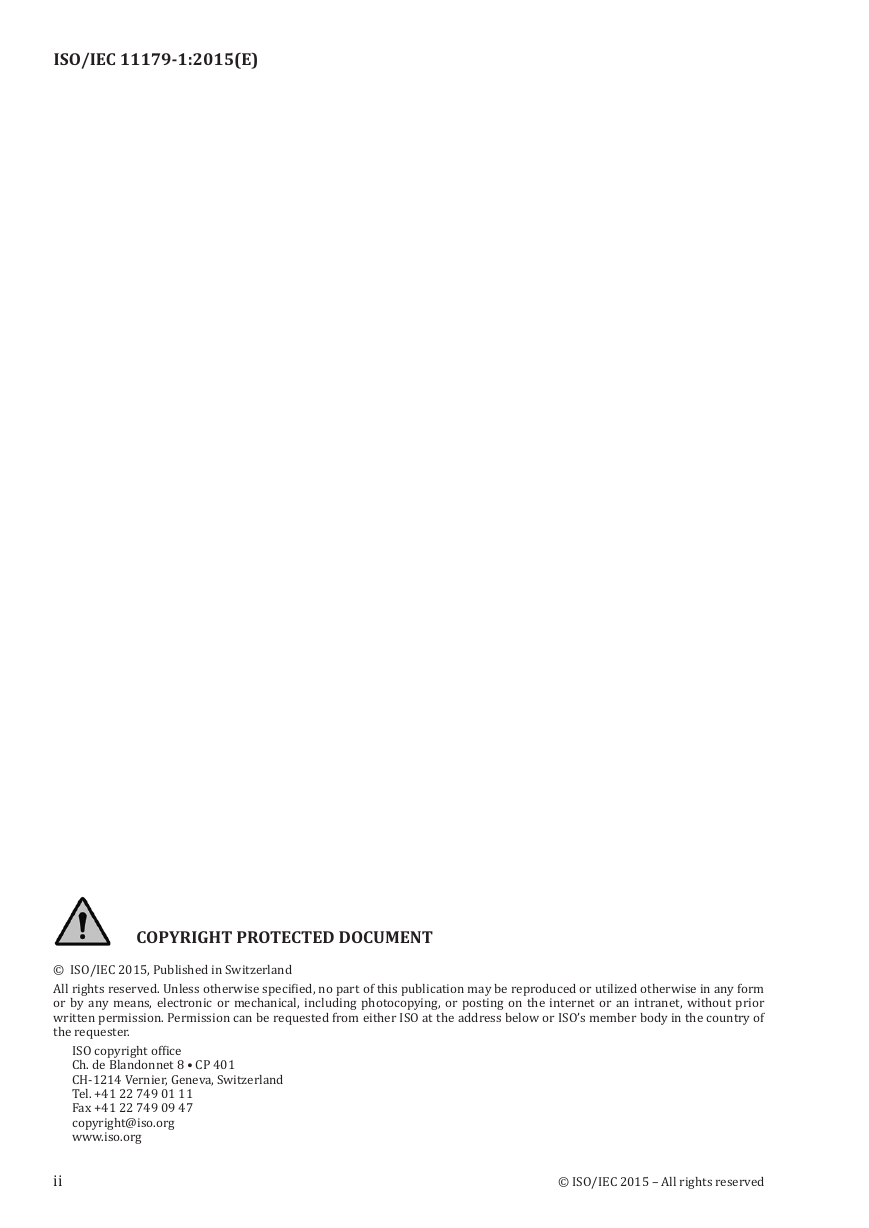

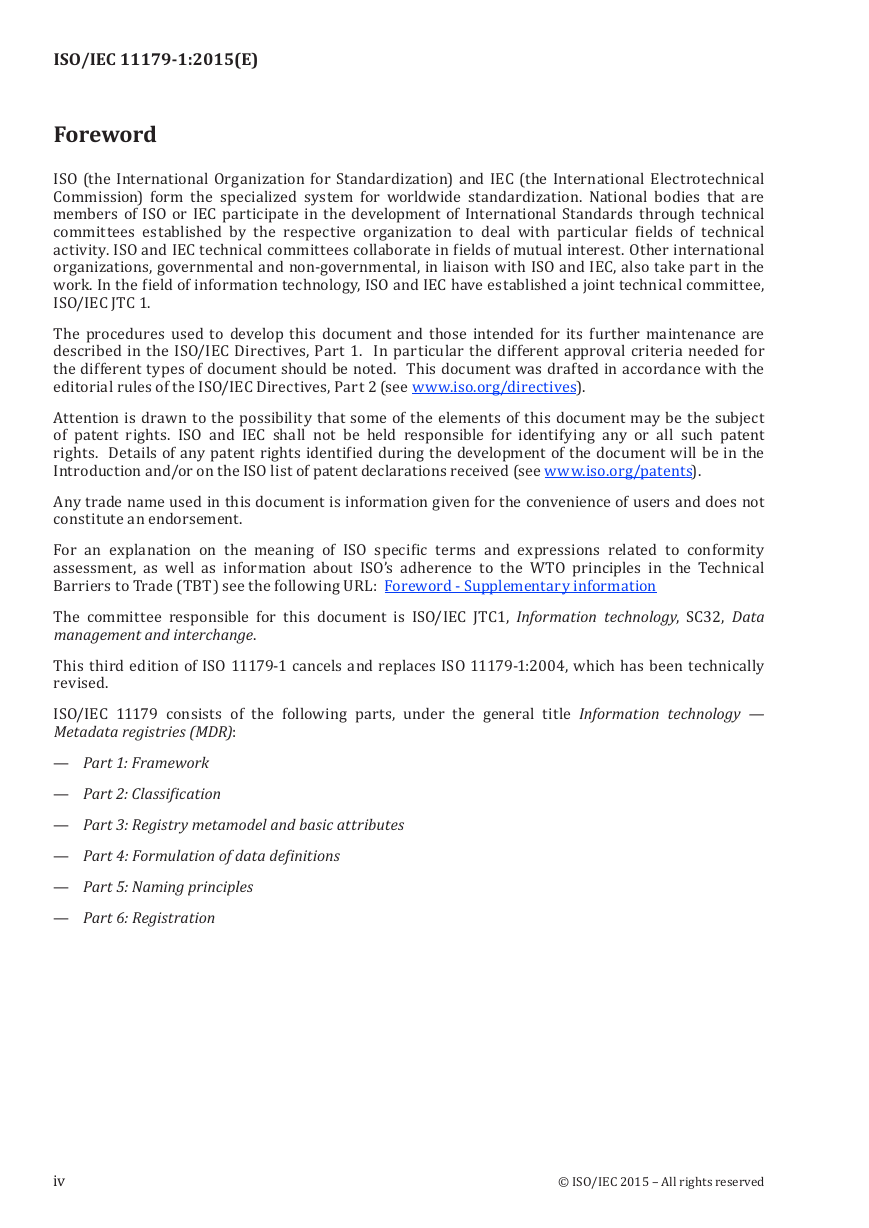
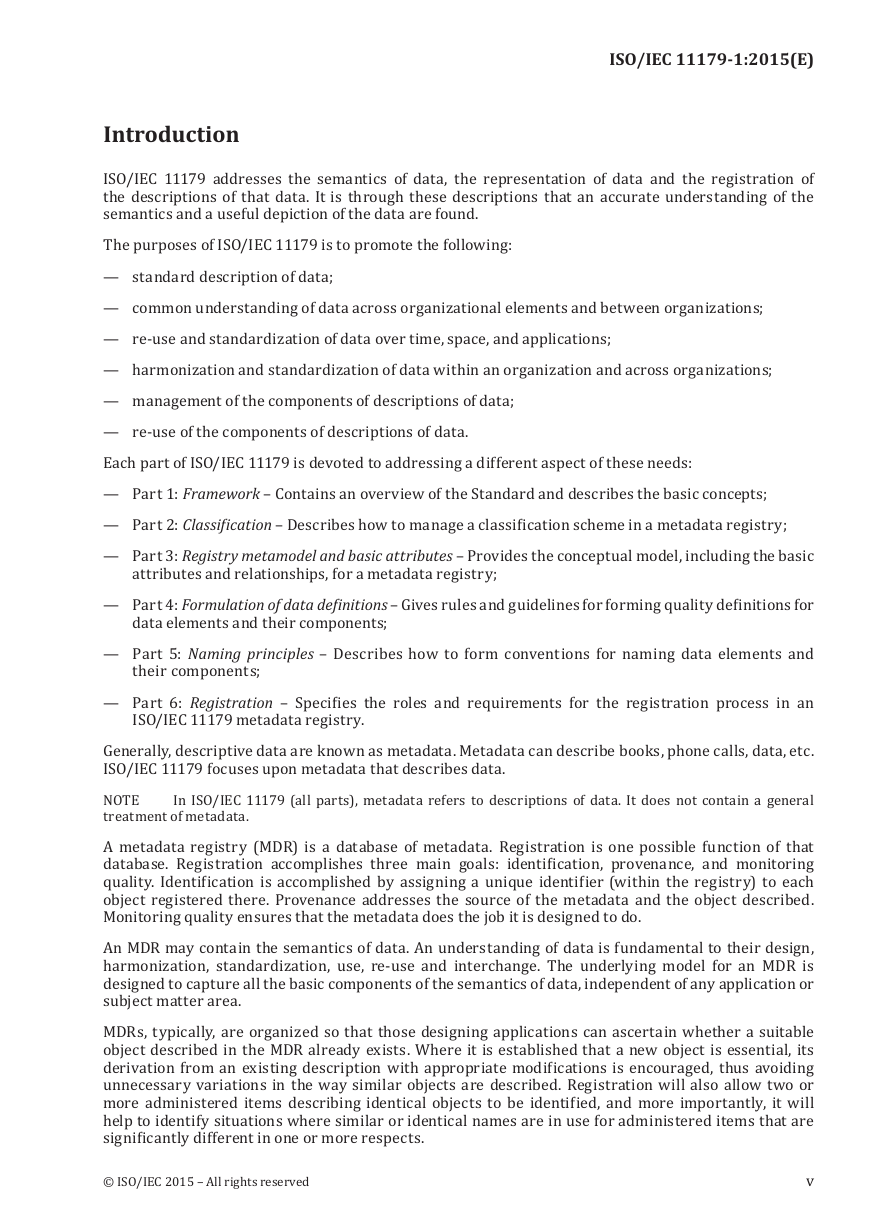
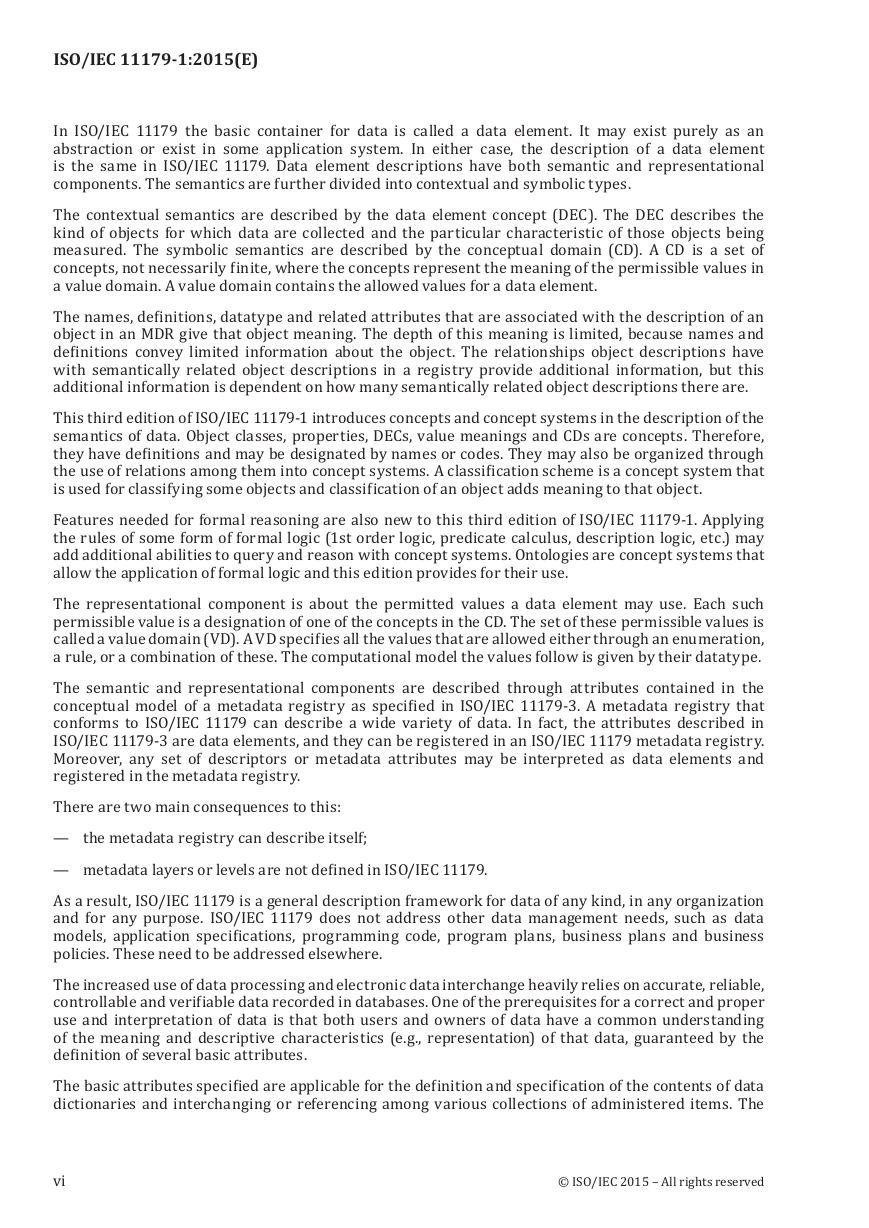
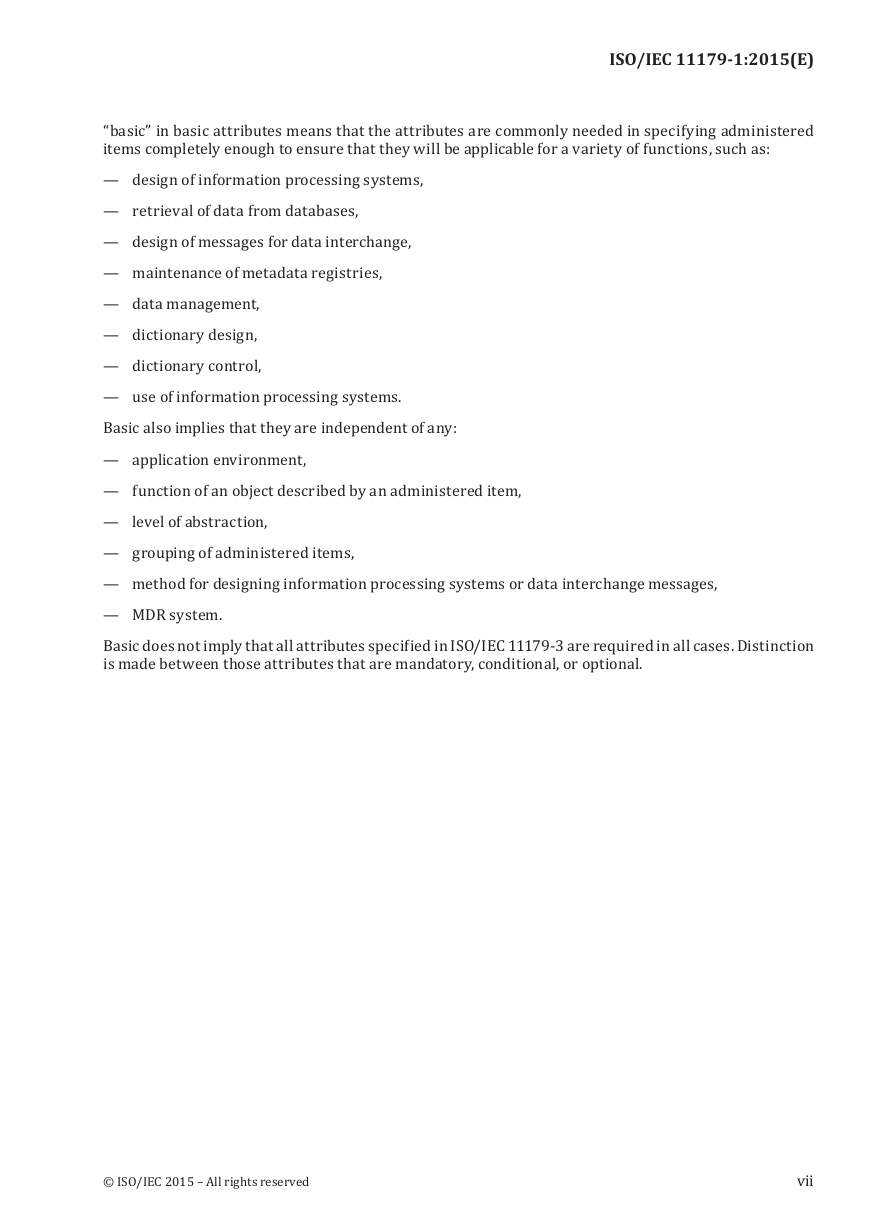









 2023年江西萍乡中考道德与法治真题及答案.doc
2023年江西萍乡中考道德与法治真题及答案.doc 2012年重庆南川中考生物真题及答案.doc
2012年重庆南川中考生物真题及答案.doc 2013年江西师范大学地理学综合及文艺理论基础考研真题.doc
2013年江西师范大学地理学综合及文艺理论基础考研真题.doc 2020年四川甘孜小升初语文真题及答案I卷.doc
2020年四川甘孜小升初语文真题及答案I卷.doc 2020年注册岩土工程师专业基础考试真题及答案.doc
2020年注册岩土工程师专业基础考试真题及答案.doc 2023-2024学年福建省厦门市九年级上学期数学月考试题及答案.doc
2023-2024学年福建省厦门市九年级上学期数学月考试题及答案.doc 2021-2022学年辽宁省沈阳市大东区九年级上学期语文期末试题及答案.doc
2021-2022学年辽宁省沈阳市大东区九年级上学期语文期末试题及答案.doc 2022-2023学年北京东城区初三第一学期物理期末试卷及答案.doc
2022-2023学年北京东城区初三第一学期物理期末试卷及答案.doc 2018上半年江西教师资格初中地理学科知识与教学能力真题及答案.doc
2018上半年江西教师资格初中地理学科知识与教学能力真题及答案.doc 2012年河北国家公务员申论考试真题及答案-省级.doc
2012年河北国家公务员申论考试真题及答案-省级.doc 2020-2021学年江苏省扬州市江都区邵樊片九年级上学期数学第一次质量检测试题及答案.doc
2020-2021学年江苏省扬州市江都区邵樊片九年级上学期数学第一次质量检测试题及答案.doc 2022下半年黑龙江教师资格证中学综合素质真题及答案.doc
2022下半年黑龙江教师资格证中学综合素质真题及答案.doc